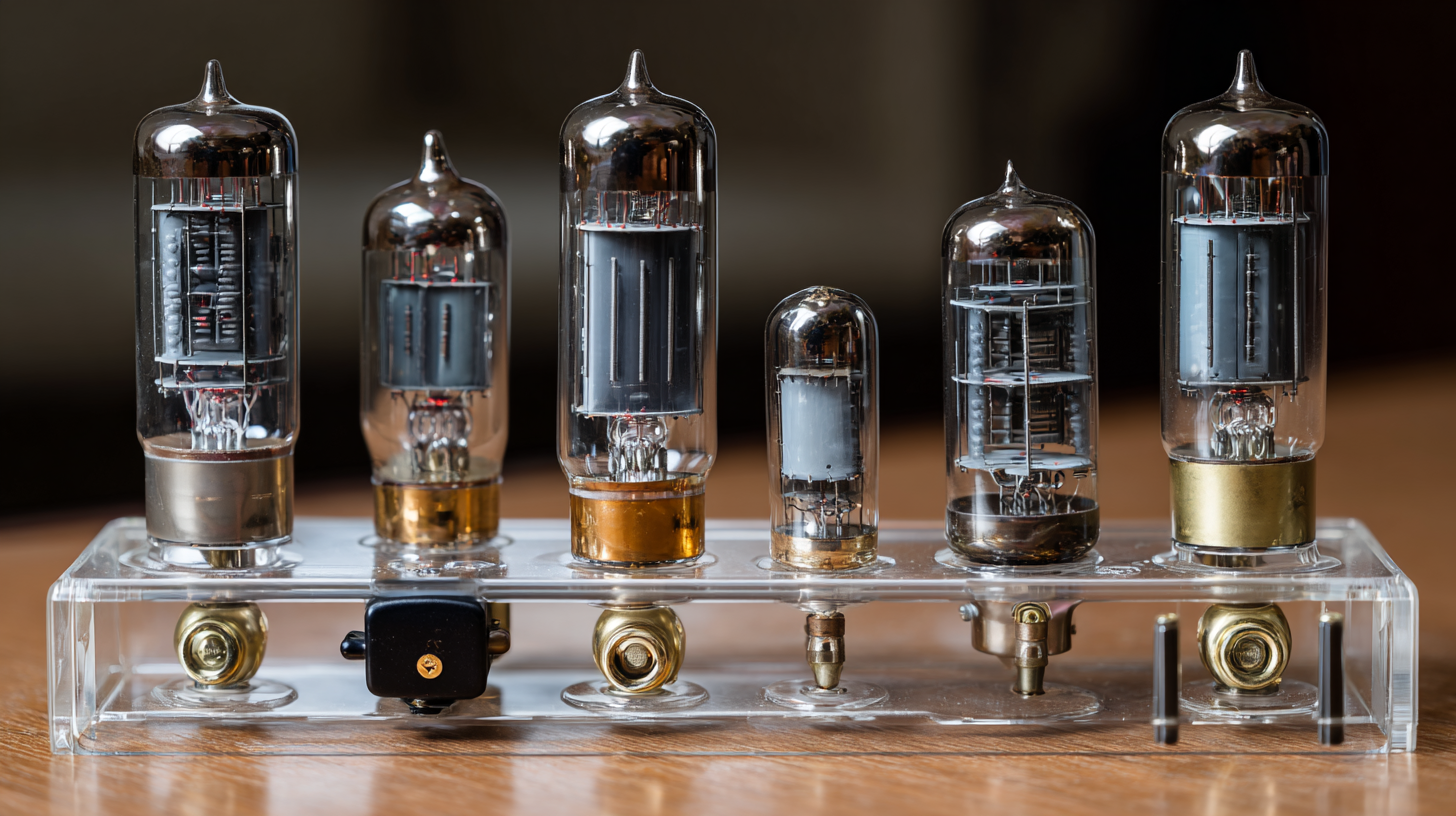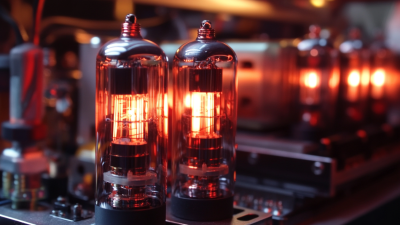In the realm of modern electronics, the seemingly humble electron tube parts have played a pivotal role in shaping technology as we know it today. As advancements continue to accelerate, understanding the significance and functionality of these components becomes essential for both industry professionals and enthusiasts alike. Dr. Emily Carter, a leading expert in electronic engineering, once remarked, “Electron tube parts are the unsung heroes of electronic innovation, enabling a variety of applications from amplifiers to oscillators.” Her insight encapsulates the critical function these components serve in enhancing performance across a multitude of devices.
Electron tube parts, often overshadowed by their semiconductor counterparts, still hold an indispensable place in various high-frequency and high-power applications. From vintage audio equipment to cutting-edge communication systems, the versatility of these tubes allows for unparalleled signal amplification and processing capabilities. Moreover, the resurgence in interest for analog sound and vintage electronics has reignited discussions about the relevance of electron tube parts in contemporary design and engineering.
As we delve deeper into the intricacies of electron tube parts, we will explore their historical context, practical applications, and the future potential they hold in a rapidly evolving electronic landscape. Understanding these components not only illuminates the path of technological progress but also inspires innovations that pay homage to the foundational elements of electronic engineering.

Electron tubes, often referred to as vacuum tubes, play a pivotal role in modern electronics, despite the dominance of solid-state devices. These components primarily function as amplifiers, oscillators, and switches, making them essential in various high-performance applications. According to a market report by Research and Markets, the global vacuum tubes market was valued at approximately $3 billion in 2022 and is projected to grow at a CAGR of over 5% from 2023 to 2028. This growth reflects the sustained demand for electron tubes in specialized fields like audio equipment, broadcasting, and military applications, where their ability to handle high voltages and provide superior audio quality is unmatched.
The resurgence of interest in electron tubes can also be observed in the audiophile community, where many enthusiasts believe that tube amplifiers produce a warmer, more natural sound compared to their transistor counterparts. A survey conducted by the Audio Engineering Society found that nearly 70% of audiophiles prefer tube-based equipment for music playback. This preference underlines the unique characteristics of electron tubes, particularly in high-fidelity audio systems. Furthermore, with advancements in manufacturing techniques and materials, modern electron tubes are being designed to be more efficient and reliable, enabling their continued relevance in an increasingly digital world.
The evolution of electron tubes has significantly shaped the trajectory of modern electronics, beginning with the vacuum tube and transitioning to solid-state technology. Early vacuum tubes, invented in the early 20th century, enabled the amplification and control of electrical signals, paving the way for the development of radio, television, and early computers. These bulky and heat-generating components relied on the movement of electrons through a vacuum, which provided a fundamental understanding of electronic behavior. Despite their initial dominance, vacuum tubes were gradually overshadowed by the advent of solid-state devices in the mid-20th century.
Solid-state technology marked a revolutionary change in the landscape of electronics. Unlike their vacuum predecessors, solid-state devices are constructed from semiconductor materials, which allow for smaller, more efficient, and more reliable components. This transition not only reduced the physical size and power consumption of electronic devices but also enabled the development of an entire range of modern technologies, from smartphones to high-performance computing systems. As the industry continues to advance, the legacy of electron tubes remains evident in the foundations of our current electronic infrastructure.
This chart illustrates the advancement of technology from electron tubes to modern solid-state devices. The data reflects the number of devices in use over the decades.
 Electron tubes, also known as vacuum tubes, continue to play a crucial role in various electronic devices today. Here are the top five applications where electron tubes have made a significant impact.
Electron tubes, also known as vacuum tubes, continue to play a crucial role in various electronic devices today. Here are the top five applications where electron tubes have made a significant impact.
First, they are extensively used in audio amplifiers, providing rich and warm sound quality that many audiophiles prefer over solid-state alternatives. These tubes can enhance the clarity and detail of music, making them a staple in high-end audio equipment.
Secondly, electron tubes are vital in radar technology, where their ability to handle high voltages and currents is essential for transmitting and receiving signals over vast distances. They contribute to the precision and reliability of radar systems, which are crucial for aviation and military applications.
Interestingly, electron tubes also find their place in medical imaging devices, such as X-ray machines. Their ability to generate and control electron flows allows for high-quality imaging, which is significant for accurate diagnosis.
Tip: When working with electronic devices that incorporate electron tubes, consider using high-quality connectors and shielding to minimize interference and maximize performance. Additionally, maintaining proper ventilation can prolong the lifespan of these components, ensuring they operate efficiently.
Electron tubes, also known as vacuum tubes, have had a significant impact on sound and signal quality in audio equipment, particularly in high-fidelity audio systems and vintage amplifiers. These devices operate by controlling the flow of electrons in a vacuum, allowing for the amplification of audio signals with a warm and rich tonal character that many enthusiasts cherish. Unlike their solid-state counterparts, electron tubes introduce a unique harmonic distortion that can enhance the overall listening experience, giving music a more organic and dynamic feel.
The choice of electron tubes in audio equipment affects the depth, clarity, and presence of sound. For instance, power tubes such as EL34 or 6L6 are celebrated for their rich mid-range and smooth high frequencies, making them ideal for guitar amplifiers. Preamp tubes, like the 12AX7, play a crucial role in shaping the initial sound before it's further amplified, adding a touch of warmth and musicality that resonates with audiophiles. Despite the advancements in solid-state technology, the nostalgic appeal and distinctive sound characteristics of electron tubes continue to influence modern audio design, bridging the gap between vintage charm and contemporary performance.
| Electron Tube Type | Impact on Sound Quality | Signal Quality | Common Applications |
|---|---|---|---|
| Vacuum Tube | Warmth and richness in sound; harmonic distortion | High noise resistance; vintage sound character | Valves in guitar amplifiers; audio mixing consoles |
| Cathode Ray Tube (CRT) | N/A | High fidelity video signal | Old television sets; oscilloscopes |
| Photo Tube | N/A | Excellent light sensitivity; low noise | Light measurements; scientific instruments |
| Gas Discharge Tube | Distinct tonal characteristics in effects | Stable operation at higher voltages | Sound effects in musical gear; lighting |
| Field Effect Tube | High fidelity and transparency; minimal coloration | High input impedance; low output distortion | Professional audio equipment; studio setups |
Electron tubes, once viewed as relics of early electronics, are making a resurgence in modern technology. As industries seek high-performance solutions, these devices find new roles in high-frequency applications, such as pulsed power systems and radio frequency amplifiers. Their ability to handle large power levels with minimal distortion offers distinct advantages over solid-state components. This adaptability positions electron tubes as critical components in sectors like aerospace and telecommunications, where reliability and efficiency are paramount.
The future of electron tubes is particularly promising in emerging technologies like quantum computing and advanced medical imaging. Researchers are exploring their integration into quantum systems, leveraging their capacity for high-speed signal processing. Additionally, in medical diagnostics, electron tubes can enhance imaging techniques by providing superior contrast and detail in images. As innovations continue, electron tubes are likely to evolve, incorporating modern materials and designs, further expanding their influence in cutting-edge applications. Their unique attributes may prove vital in overcoming the limitations faced by current semiconductor technologies, ensuring their relevance in an increasingly digital world.







